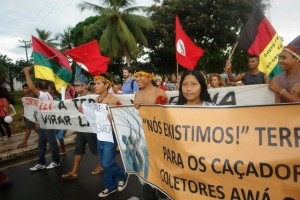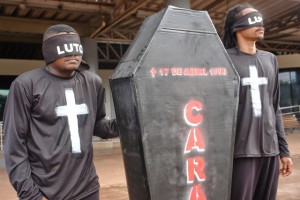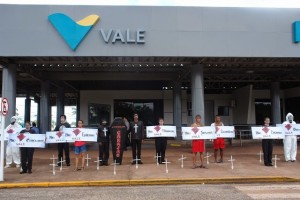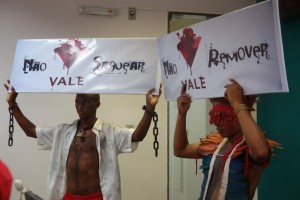 Started during the military dictatorship, the Carajás Project has, in three decades, made Brazil a mining power. Social movements, ecclesial groups and human rights institutions are assessing the impacts, while Vale, the second largest mining company in the world, prepares to double iron production in the coming years.
Started during the military dictatorship, the Carajás Project has, in three decades, made Brazil a mining power. Social movements, ecclesial groups and human rights institutions are assessing the impacts, while Vale, the second largest mining company in the world, prepares to double iron production in the coming years.
“It’s like a trip back in time,” explains Santiago Machado Aráoz, an anti-mining activist from Andalgalá in Catamarca, when asked about the reality of Piquiá, the industrial neighborhood in Açailandia contaminated by the plants that produce cast iron from Carajás iron ore.
“Cobbled streets, simple wood houses, the loud passing of the train, and permanent iron dust make up the landscape–gray by day, and a smoky reddish by night, because they operate 24 hours a day.”
Santiago was one of the hundreds of participants in the international seminar, “Carajás, 30 Years” in São Luis, the capital of Brazil’s poorest state, Maranhao, organized by an alliance between the Landless Workers’ Movement (MST), the Justice on the Rails Network (Red Justiça Nos Trilhos, an initiative of the Comboni Missionaries), the Carajás Forum, Cáritas, and the Development, Modernity, and Environment Group at the Federal University of Maranhão.
About a thousand people attended the seminar, held May 5-9, from several Brazilian states and a dozen countries where there are mining activities. Representatives from anti-mining organizations in Argentina, Chile, Peru, Mexico, and Colombia, activists from Canada and Germany made presentations and “The Fight of the People against the Iron Dragon,” a film by local filmmaker Murilo Santos was shown.
Critics of the Grand Carajás Project, initiated by the military dictatorship in 1982, focused on Piquiá plant pollution and the damage caused by the train when it crosses more than one hundred villages, considered the largest mining-based railway in the world. Unlike other mining ventures, the social damages here are even worse than the environmental damages, although the environmental impact affects the Amazon rainforest, a sensitive and fragile ecosystem.
The people directly affected by Vale–peasant farmers, indigenous peoples, and the inhabitants of polluted communities like Açailandia and Piquiá–played a prominent role in the conference. The week culminated in a march from the university to the government palace in the historical downtown area. There, they harshly criticized Governor Roseana Sarney–a member of the local oligarchy that has held the state for many decades.
An imperial project
A US Steel geologist discovered the richest mineral area and the largest iron reservoir in the world in 1962–900,000 square kilometers, 10% of Brazil’s land surface through which the Tocantins, Araguaia and Xingú rivers of the Amazon flow. The Brazilian government entered into a dispute with the US multinational to make sure the resulting wealth stayed in the country, Companhia Vale do Rio Doce (Vale), the state mining company founded in 1942 by the Getúlio Vargas government, paid a huge sum to U.S. Steel for a mining monopoly.
Seven decades later, Vale is the second largest mining entity in the world, with 120,000 employees and USD $60 billion in annual invoices. It operates in twenty countries and is among the twenty largest companies in the world. The company has 10,000 kilometers of railways and nine of its own ports in Brazil alone, through which it exports iron ore to Asia. China is Vale’s prime customer. China consumes 5% of the energy produced in Brazil.
The Fernando Henrique Cardoso government privatized Vale in 1997, in a controversial process. Although it is formally a private company, the state has a “golden share” through which it can block decisions. The Board of Directors is controlled by Valepar SA, where Previ (the pension fund of the employees of state-owned Banco do Brasil) holds 53% of capital with voting rights. The Brazilian Development Band (BNDES) has another 10%. This allows the government to influence, either directly or through trade unions, the multinational’s presidential elections and the orientation of its investments.
 Vale’s crown jewel is the Carajás Project. Its iron ore has the highest degree of purity in the world, and in such quantity that it can be extracted for another 250 years at current rates. The Carajás Project complex includes the mine, a 900-kilometer railway, and a port at São Luis. To supply the mine and other aluminum projects in the Amazon with power, the construction of the Tucuruí hydroelectric plant– with a capacity of 8,300 megawatts–was necessary.
Vale’s crown jewel is the Carajás Project. Its iron ore has the highest degree of purity in the world, and in such quantity that it can be extracted for another 250 years at current rates. The Carajás Project complex includes the mine, a 900-kilometer railway, and a port at São Luis. To supply the mine and other aluminum projects in the Amazon with power, the construction of the Tucuruí hydroelectric plant– with a capacity of 8,300 megawatts–was necessary.
Of the 100 million tons of iron Vale exports each year, some 75 million are taken from the Carajás mine. Drills extract the ore that is lifted by excavators to trucks capable of carrying up to 400-ton loads. From there, it goes to the plants that grind the ore, until it arrives at the railcars via a network of conveyor belts. The mining train has 330 cars, four locomotives, and a length of nearly four kilometers. The Valemax, 360-meter long cargo boats of up to 400,000 ton built especially to transport iron, await the train at the port. Vale has commissioned 35 of these mega-ships.
Sacrifice zones
“The company’s presence was naturalized, and now there is no way to think about getting rid of it. The train has a continuous presence and disrupts daily life,” Santiago says. The worst impacts come from the company’s steel plants, five in Açailandia and two in Piquiá. With just 380 families, the community nestled in this industrial area is not strong enough to protest, although with support from the landless movement and local priests several hundred people blocked the railway in December 2011.
“After being here for awhile, my face and arms started to itch. It’s the steel dust. The company does not have a dump or a slagheap, but just keep pulling it out there.” Santiago does the math. He visited three houses: one family had a 15 year-old girl with deformities, in the second, a 32 year-old woman had died of cancer, in the third, a member of the family had lung cancer.
Joselina, an elegant woman in her 40s, attends graduate school in São Luis but her entire family is in Piquiá. She cannot hide her sadness over the death of her little cousin, ten years old. He was burned to death when he fell into the waste from the plants. “Piquiá is surrounded by steel plants, cement factories, and the Vale train, and trucks carrying iron ore and coal pass through on the roads all the time.”
“There is so much oppression that all people want is to leave,” Santiago notes. The companies bought some property for the people so they could move to a less bleak and polluted place, and last year the Ministry of Cities approved an urban housing project for them to re-settle. Problems will continue along the 900 kilometers of the railway that Vale plans to double in a few years to boost exports. The goal is to go from 100 to 230 million tons of iron ore.
Each time the train stops, it forms a four-kilometer wall that local people cannot cross. Perhaps that’s why Santiago compares Açailandia to Macondo. “It beats fiction. There are dead fish in all of the rivers, everything is black or white because the iron dust strips the color away from people and plants.” This image is reinforced every time the train stops at a village and hundreds of people rush to sell anything for a few reais.
The worst company in the world
Father Dario Bossi of the Comboni Missionary coordinates the Justice on the Rails Network and lives in Piquiá. He states, “In thirty years, iron exploitation leaves deforested areas, slave labor, migration and has torn apart the identification of the communities with their territories. It has also left land conflicts, pollution, urban disorganization, and violence due to the intense exodus of people in search of work, the most affected being of indigenous or African descent.”
 “Decades ago, caravans of impoverished people from the Northeast came to Maranhão– cheap labor for large development projects and extensive plantation farming,” Bossi states [1]. Towns near the mine have experienced geometric growth. Marabá had a population of 14,000 in 1960; today it has 250,000. Parauapebas, where the railway begins, had 20,000 people when the Carajás project started in 1980; today it nears 200,000. Intense migration, poverty, and violence go hand in hand.
“Decades ago, caravans of impoverished people from the Northeast came to Maranhão– cheap labor for large development projects and extensive plantation farming,” Bossi states [1]. Towns near the mine have experienced geometric growth. Marabá had a population of 14,000 in 1960; today it has 250,000. Parauapebas, where the railway begins, had 20,000 people when the Carajás project started in 1980; today it nears 200,000. Intense migration, poverty, and violence go hand in hand.
Bossi recalls “unemployment is higher in the municipalities that the railway passes through–21 of those 27 municipalities have a human development index at less than half the average for the state of Maranhão.”
The words “poverty,” “dictatorship,” and “colonialism” recur again and again in the seminar on Vale. In 2011, it received an “award” for being the worst company in the world. The annual “Public Eye People’s Award”, created by NGOs Greenpeace and Berne Declaration was granted to Vale for its “70-year history sullied by repeated human rights violations, inhumane labor conditions, pillage of public assets, and cruel exploitation of nature “[2]. That year, votes for Vale even exceeded those for Japan’s largest electricity company, Tepco, responsible for the Fukushima disaster.
Brazil is currently debating a new mining code that would regulate mining activity through 2030. So far the National Mining Plan’s only concession is an increase in royalties.
Father Bossi notes, “The project has been decided from above, without dialogue with communities and without a plan for integrating socio-economic and environmental management. It is at the exclusive service of the mining and iron and steel industry”. [3]
The National Committee in Defense of Territories Against Mining (Comitê Nacional em Defensa dos Territórios Frente a Mineração), composed of eleven movements and organizations, issued a statement denouncing a conflict of interest in the case of Deputy Leonardo Quintão (of the Brazilian Democratic Movement Party, PMDB). Quintão is the rapporteur for the mining code to be voted in the chamber, and mining companies funded 20% of his campaign. [4]
Large companies tend to finance party campaigns. For the 2010 presidential election, Vale donated 30 million reais to parties (some USD $15 million). The party that received the most donations was the ruling PT (Worker’ Party), with 10 million reais. [5]
Oligarchy and the State
In February 2011 the twelve bishops and the archbishop of the Northeastern region of the National Conference of Brazilian Bishops issued a letter on the occasion of the yearly meeting held in southern Maranhão. “The history of Maranhão, Brazil, has been marked by small groups–through political influence and active corruption–appropriating for themselves that which belongs to all” [6].
Though the bishops do not mention the word “oligarchy,” their description refers to the Sarney family that has ruled the state for half a century.
“We can’t allow the state to continue placing itself at the exclusive service of the major mineral, soybean, juice, and meat exporters, building the necessary infrastructure for them to obtain higher and higher profits.”
José Sarney began his political career in the early 1960s. He was governor of Maranhão during the military dictatorship, from 1966 to 1971. Later he was a senator, also under the dictatorship, and president [of Brazil] from 1985 and 1990, following the death of President Tancredo Neves. He became a senator again, this time in the democracy, until he was elected president of the Chamber of Deputies in 2009. His daughter Roseana is following the same path; she was deputy, senator and twice governor of Maranhão, a position she currently holds. Corruption allegations prevented her from running for the presidency in 2002.
Face of so much wealth and power, the “Carajas 30 Years” Seminar submitted a list of thirteen demands. The demands are simple and easy to adopt. The fact that they have not been agreed to demonstrates the lack of political will on the part of the company and the state government.
The first demands include that Vale “build safe crossings along the railway,” conduct appropriate studies for the doubling of the railway, ” refrain from spying and infiltrating social movements with intelligence agents,” and take measures to reduce train noise, among other things. [7]
 The links between Vale and the Sarney group have been well documented. Even the Supreme Electoral Tribunal investigated and questioned suspicious donations from mining and construction companies and banks. [8] The local oligarchy was reinforced by the arrival of the Luiz Inácio Lula da Silva government in 2003, since the founder of the dynasty, José Sarney, was chosen as an ally. He supported Lula’s government in parliament.
The links between Vale and the Sarney group have been well documented. Even the Supreme Electoral Tribunal investigated and questioned suspicious donations from mining and construction companies and banks. [8] The local oligarchy was reinforced by the arrival of the Luiz Inácio Lula da Silva government in 2003, since the founder of the dynasty, José Sarney, was chosen as an ally. He supported Lula’s government in parliament.
Eduardo Viveiros de Castro, currently the most recognized Brazilian anthropologist, attempts to explain these continuities against the backdrop of the June 2013 demonstrations that opened a new chapter for the country. He argues that Brazil is different from other countries in the region, characterized by scarce political participation and low popular mobilization. He believes his country is more racist than the United States: “Brazil continues to be a slave country, because its deep conscience is still based on slavery.” [9]
Viveiros de Castro says something else, something very uncomfortable. The PT chose the path of “improving the income of the poor without touching the income of the rich. So we have to get the money from somewhere else. Where? From the ground, literally.”
He concludes that the extractive model is the path of today’s progressivism.
“It’s destroying Brazil and devastating the Amazon, to avoid touching the purses of the rich”.
Raúl Zibechi is international relations editor at the magazine Brecha in Montevideo, adviser to grassroots organizations and writer of the monthly Zibechi Report of the CIP Americas Program www.americas.org
Translation: Paige M Patchin
NOTES:
[1] Entrevista con Dário Bossi, IhuOnline, 24 de abril de 2014.
[2] O Estado de São Paulo, 26 de enero de 2012.
[3] Entrevista con Dário Bossi, IhuOnline, 24 de abril de 2014.
[4] Publicado el 12 de mayo de 2014, en http://global.org.br/programas/o-novo-codigo-da-mineracao-nao-pode-ter-a-relatoria-de-um-representante-das-mineradoras-do-pais/
[5] Clarissa Reis Oliveira, “Quem é quem nas discussões do novo código da mineração“, Rio de Janeiro, Ibase, 2013.
[6] En Justiça nos Trilhos, “Não Vale. Duplicação do lucro privado e dos impactos coletivos”, Anexo.
[7] Seminario Internacional 30 Años,8 de mayo de 2014 enhttp://justicanostrilhos.org/Ato-em-defesa-das-comunidades
[8] Wagner Cabral da Costa, “Pelo zapato furado: bipolarição e reestruração oligárquica da política maranhense”, en A terceira margem do rio, São Luis, Edufma, 12009. Pp. 95-110.
[9] “A escravidão venceu no Brasil. Nunca foi abolida”. Entrevista com Eduardo Viveiros de Castro, en http://www.publico.pt/mundo/noticia/a-escravidao-venceu-no-brasil-nunca-foi-abolida-1628151



